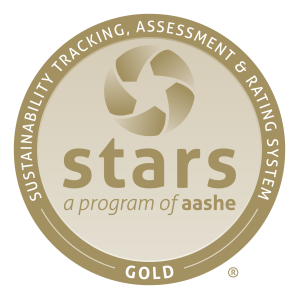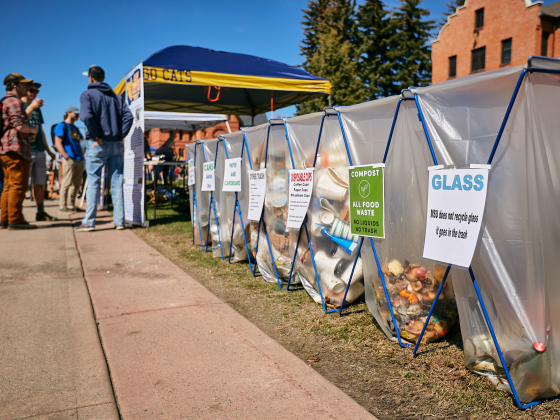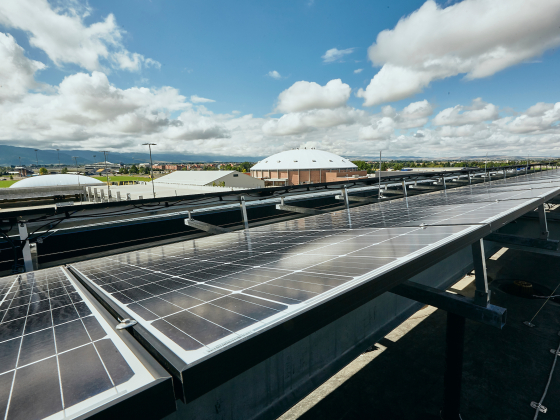Located in Bozeman, MT
For questions or comments contact the Ask Us Desk.
NOVEMBER 30, 2023
BOZEMAN – Montana State University has earned a prestigious STARS Gold rating in recognition of its comprehensive sustainability achievements from the Association for the Advancement of Sustainability in Higher Education.
STARS, the Sustainability Tracking, Assessment and Rating System, is a widely used framework developed by the higher education community that measures and encourages sustainability at colleges and universities. MSU’s STARS report is publicly available on the STARS website.

“STARS was developed by the campus sustainability community to provide high standards for recognizing campus sustainability efforts,” said AASHE Executive Director Meghan Fay Zahniser. “Montana State University has demonstrated a substantial commitment to sustainability by achieving a STARS Gold Rating and is to be congratulated for their efforts.”
“We are immensely proud of this achievement,” said MSU President Waded Cruzado. “Thanks to the intentional work of our MSU Office of Sustainability and our facilities staff, as well as the support of students and faculty, Montana State has made significant progress in all aspects of sustainability, and this new rating highlights our commitment to integrate it into our campus culture.”
STARS ratings are based on a comprehensive self-assessments process. MSU first submitted a STARS report in 2019 and was awarded a silver rating. More than 900 institutions in 40 countries participate in the STARS program. Data for the report looks at five broad areas: academics, engagement, operations, planning and administration, and innovation and leadership.
MSU’s sustainability initiatives are led by its Office of Sustainability, which was established in 2012 and works with students, faculty, staff and community members to develop goals and sustainable practices on campus, such as sustainable transportation, energy efficiency, recycling and local food programs.
The office also hosts an annual Sustainability Summit which draws hundreds of attendees to hear presentations on MSU’s Sustainability Framework, STARS and MSU’s approaches toward energy conservation and efficiency, according to Kristin Blackler, director. In addition to campus sustainability tours, the summit highlights cutting edge, high-impact sustainability research by current MSU undergraduate and graduate students. Blackler added that 30 out of 32 academic departments offer sustainability-related courses, and 32 out of 33 research groups participate in sustainability research.
In 2021, MSU adopted its Sustainability Framework, which set three major goals for the university: Meet the internationally recognized “zero waste” standard by diverting at least 90% of its waste from landfills through recycling and other programs by the year 2035; achieve a STARS Platinum by 2035; and reduce overall MSU greenhouse gas emissions and achieve carbon neutrality by 2040.
“Montana State’s commitment to sustainability is deeply ingrained in our operations, research and community engagement,” said Blackler. “STARS Gold is a proud moment for us, reflecting our dedication to being good stewards of the environment. We’re excited to continue our journey toward sustainability excellence and lead by example in higher education.”
Twelve of MSU’s buildings are certified by LEED, a worldwide green building certification program that encourages new facilities to be energy efficient and environmentally responsible. Two of those buildings, American Indian Hall and Norm Asbjornson Hall, hold the highest LEED certification of Platinum.
In 2020, MSU was featured as a case study in energy efficiency strategies by the National Renewable Energy Laboratory for its development of innovative and interconnected energy districts on campus. Buildings connected to these districts use technologies such as solar walls and heat pumps to regulate temperatures, transferring heat where it’s needed, even if that’s another building, or storing heat in deep geothermal boreholes drilled into the earth for later use.
Building on the success of recent energy-efficiency improvements that have already saved MSU millions of dollars in reduced utility costs, the university has also partnered with design firm Cushing Terrell to provide engineering services related to future geothermal technology, heat pumps and the innovative energy districts that have earned MSU national recognition in order to optimize how new and existing buildings integrate with the university’s energy facilities.
With construction of the Student Wellness Center underway in the South Campus District and two new buildings — to house computer science and nursing — slated for nearby, the planning work comes at an opportune time, according to Megan Sterl, MSU’s director of engineering and utilities.
“The planning we do now will ensure that we’re taking full advantage of the opportunities we have, especially in this growing area of South Campus, to save energy over the lifetime of these buildings,” Sterl said. “When we use less energy, we not only cut our carbon emissions but also significantly reduce the amount of money it takes the university to operate.”



